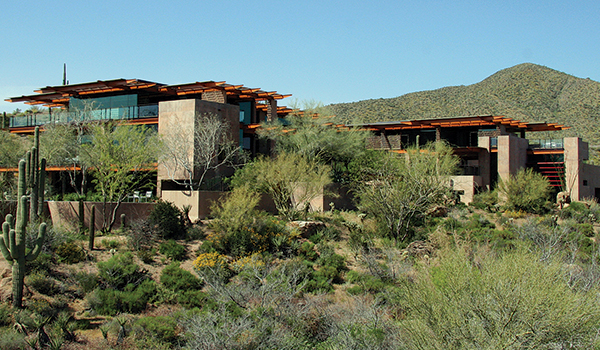
 With “luxury home” generally defined as a home valued at $500,000 or more, a high percentage of Valley homes would have fallen into that category only a few years ago. Today, however, with the average Valley single-family residence valued at $160,000, “luxury home” encompasses a more select market.
With “luxury home” generally defined as a home valued at $500,000 or more, a high percentage of Valley homes would have fallen into that category only a few years ago. Today, however, with the average Valley single-family residence valued at $160,000, “luxury home” encompasses a more select market.
Luxury properties span the Valley in gated and non-gated communities, and include horse properties and golf properties. Number of active days on the market increases with listing price, averaging 133 days for houses in the $500,000 to $600,000 range and 373 days for houses listed at more than $3 million. The average listing in the luxury category is $1.35 million, and Lein notes appreciation is not markedly different from a year ago. Compared to non-luxury properties of $100,000 to $200,000 that appreciated 28 percent per square foot in the past 18 months, luxury home prices increased $3 per square foot.
A little more than 2,400 homes now on the market in the Greater Phoenix area qualify as luxury homes. Selling at an average of 250 per month, this is a 9.4-months’ supply; a year ago, there was an approximately 12.5-month supply. So the glut of homes on the market is definitely receding, and W. P. Carey School of Business reported in October that there were more buyers than sellers in today’s housing market overall.
Only a small percentage of homes in the luxury bracket are lender-owned, notes Howard Lein, owner of Scottsdale-based franchise RE/MAX Excalibur Realty. Percent of active listings has dropped from 3 percent a year ago to 1.6 percent today.
In fact, foreclosed properties overall is no longer a dominant issue. While America’s housing market is finally starting to really recover from the Great Recession, some areas of the country are fighting back faster than others. New research from the W. P. Carey School of Business at Arizona State University indicates one reason: Different states have dramatically different mortgage laws, and some — like Arizona — make it easier to push through tough times.
“The laws across states use different legal theories as the basis for mortgages, and they balance the rights of creditors and borrowers very differently,” explains Assistant Professor of Real Estate Andra Ghent of the W. P. Carey School of Business. “The variations started early in America’s history, and they’re not really based on economic reasons, but they’re still having a major influence on what’s happening now with the housing market.” Key, she says, is quick resolution of the situation. “For example, if a state requires a longer period before foreclosures can happen, then that generally means the homes deteriorate more as the borrowers realize they’re going to have to leave and stop taking care of the property. This is bad for the neighbors and the property values.”
Arizona is one of the states in which the damage happened relatively quickly, and there’s no longer a big backlog of foreclosures to go through the process. Center for Real Estate Theory and Practice at the W. P. Carey School of Business data shows Phoenix-area home prices have been rising dramatically since last fall.
The market is seeing “some push-back from second-home owners who are concerned about maintaining their second-home lifestyle” in light of possible tax changes, Lein says. Other reasons for selling, he says, fall into the usual categories: death, divorce, relocation and kids growing up. And Lein observes, “There’s a pent-up demand for divorce. People couldn’t afford to get a divorce” when they were underwater on their mortgage.
There is some speculative purchasing, but that is primarily for the foreclosed properties. Other buyers of luxury homes are “move-up individuals,” says Lein, pointing out that even if unemployment is in the high teens, there’s another 80 percent who “are working and susceptible to moving up.” And then there are the multi-nationals who are buying their luxury homes here. Canadians make up a large part of this market; joining them are individuals from Pacific Rim countries, and new to the mix are Chinese. According to Lein, purchases by Chinese are largely trophy properties on the West Coast, but “Paradise Valley has had some sale to what’s reported to be Chinese, who are so new [to Arizona] that, in many cases, they’ve never seen the property” in person.
Lenders today have more to offer this market. Lein notes that two to three years ago, “there was literally nothing available.” But now, he says, “Every week, I’m being approached with new and improved financing programs for luxury-home buyers.”
















